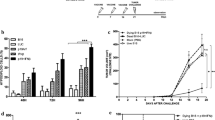Summary
The objective of this study was to evaluate if pretreatment with Corynebacterium parvum (C. parvum) augments the effects of interferon (IFN) inducers on survival of DBA/2 mice transplanted with two syngeneic lymphoma variants, the low metastatic Eb and the high metastatic ESb tumor. The involvement of IFN in the treatment effects was investigated. As inducers of IFN-α/β Newcastle disease virus (NDV), polyinosinic-polycytidylic acid (polyI:polyC), and 10-carboxymethyl-9-acridanone (CMA) were injected i. p. at the site of tumor transplantation. The Eb tumor was found to be sensitive to the antiproliferative action of IFN-α/β in vitro. In vivo single injections of each of the inducers retarded growth of the Eb tumor. In C. parvum-pretreated mice the effects of the inducers on survival were markedly increased. There was a correlation between prolonged survival and local IFN levels in response to polyI:polyC or CMA but not upon NDV. Injections of each of the inducers increased cytotoxicity of peritoneal exudate cells against the Eb tumor cells in vitro especially when mice were pretreated with C. parvum. Although other mechanisms cannot be excluded IFN-mediated activation of host defence and also direct antiproliferative effects of endogenously produced IFN seem to be involved in the antitumor effects by these IFN inducers in the Eb model. In the ESb tumor model irrespective of additional pretreatment with C. parvum survival was only slightly prolonged by the treatments and endogenous IFN induction did not result in any real benefit for the animals. When compared with Eb cells the ESb cells were less sensitive to the antiproliferative action of IFN-α/β in vitro and less sensitive to in vitro cytotoxicity by the host cells. Although other mechanisms may additionally be active in vivo the different susceptibility of the Eb and ESb tumor cells to the direct and indirect actions of IFN seems to contribute to the different responsiveness of these tumor cell lines to the treatments with IFN inducers.
Similar content being viewed by others
References
Balkwill FR, Goldstein L, Stebbing N (1985) Differential action of six human interferons against two human carcinomas growing in nude mice. Int J Cancer 35:613
Bart RS, Kopf AW, Vilcek J, Lam S (1973) Role of interferon in the anti-melanoma effects of poly(i). poly(C) and Newcastle disease virus. Nature 245:229
Bosslet K, Schirrmacher V (1982) High-frequency generation of new immunoresistant tumor variants during metastasis of a cloned murine tumor line (ESb). Int J Cancer 29:195
Brunda MJ, Rosenbaum D, Stern L (1984) Inhibition of experimentally-induced murine metastases by recombinant alpha interferon: correlation between the modulatory effect of interferon treatment on natural killer cell activity and inhibition of metastases. Int J Cancer 34:421
Dianzani F, Baron S (1975) Unexpectedly rapid action of interferon in physiological conditions. Nature 257:682
Djeu JY, Heinbaugh JA, Vieira WD, Holden HT, Herberman RB (1979) The effect of immunopharmacological agents on mouse natural cell-mediated cytotoxicity and on its augmentation by polyI:C. Immunopharmacology 1:231
Gresser I (1985) How does interferon inhibit tumor growth? Interferon 6:93
Gresser I, Bourali C (1969) Exogenous interferon and inducers of interferon in the treatment of Balb/c mice inoculated with RC19 tumor cells. Nature 223:844
Gresser I, Tovey M (1978) Antitumor effects of interferon. Biochim Biophys Acta 516:231
Gresser I, Maury C, Bandu MT, Tovey M, Maunoury MT (1978) Role of endogenous interferon in the anti-tumor effect of polyI:C and statolon as demonstrated by the use of antimouse interferon serum. Int J Cancer 21:72
Heicappel R, Schirrmacher V, von Hoegen P, Ahlert T, Appelhans B (1986) Prevention of metastatic spread by postoperative immunotherapy with virally modified autologous tumor cells. I. Parameters for optimal therapeutic effects. Int J Cancer (in press)
Yocata Y, Kishida T, Esaki K, Kawamata J (1976) Antitumor effects of interferon on transplanted tumors in congenitally athymic nude mice. Biken J 19:125
Kirchner H, Weyland A, Storch E (1983) Increased interferon production in mice pretreated with Corynebacterium parvum. J Interferon Res 3:351
Kobayashi H (1979) Viral xenognisation of intact tumor cells. Adv Cancer Res 30:279
Levy HB, Riley FL (1983) A comparison of immune modulating effects of interferon and interferon inducers. Lymphokines 8:303
Milas L, Scott TM (1978) Antitumor activity of Corynebacterium parvum. Adv Cancer Res 26:257
Poduval T, Seshadri M, Sundaram K (1984) Enhanced host resistance to transplantable murine lymphosarcoma in Swiss mice by combined immunostimulation with BCG and polyinosinic-polycytidylic acid. J Natl Cancer Inst 72:139
Russel PH, Alexander DJ (1983) Antigenic variation of New-castle disease virus strains detected by monoclonal antibodies. Arch Virol 75:243
Schirrmacher V, Bosslet K, Shantz G, Clauer K, Hübsch D (1979) Tumor metastases and cell-mediated immunity in a model system in DBA/2 mice. IV. Antigenic differences between the parental tumor line and its metastasizing variant. Int J Cancer 23:245
Schirrmacher V, Fogel M, Russmann E, Bosslet K, Altevogt P, Beck L (1982) Antigenic variation in cancer metastasis. Immune escape versus immune control. Cancer Metastasis Rev 1:241
Schultz RM, Papamatheakis JD, Chirigos MA (1977) Interferon: the ultimate inducer of macrophage activation by polyanions. Science 179:674
Storch E, Kirchner H (1985) Interferon inducibility in mice treated with Corynebacterium parvum. Antiviral Res 5:117
Storch E, Baumgartl D, Kirchner H (1984) Protection by polyI:polyC against infection with herpes simplex virus in mice pretreated with Corynebacterium parvum. Nat Imm Cell Growth Reg 3:134
Taylor JL, Schoenherr CK, Grossberg SE (1980) High yield interferon induction by 10-carboxymethyl-9-acridanone in mice and hamsters. Antimicrob Agents Chemother 18:20
Author information
Authors and Affiliations
Rights and permissions
About this article
Cite this article
Storch, E., Kirchner, H. & Schirrmacher, V. Prolongation of survival of mice bearing the Eb and ESb lymphoma by treatment with interferon inducers alone or in combination with Corynebacterium parvum . Cancer Immunol Immunother 23, 179–184 (1986). https://doi.org/10.1007/BF00205647
Received:
Accepted:
Issue Date:
DOI: https://doi.org/10.1007/BF00205647




